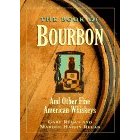
Prior to visiting Kentucky, I looked for travel books on the region and its whiskey industry. Surprisingly enough, there’s not a travel guide dedicated to Kentucky–the usual suspects such as Lonely Planet cover it by merging it with a number of other states, including Tennessee–and a “whiskey trail” book hasn’t really been done, although this book by Gary and Mardee Regan is close. I found this ten-year-old book earlier this year during one of my used-book searches for cocktailian tomes. It had two things going for it: I knew the author, and it filled a gap in my library of bachannalia on this quintessential American liquor. While it didn’t prove as useful as a guide to the state, it was invaluable in my education on how American whiskey is made, so that when I did make it to the Jim Beam and Maker’s Mark distilleries, I already knew much of what their short films and tours showed me, so that I could concentrate on the first-hand experience and the fine details, rather than starting from scratch.
Describing how whiskey is made is a third of this book. One third is given up to covering as many of the labels existing at the time (1995), including not only tasting notes but extended histories that cover who originated the label/recipe, if it changed, and, finally, who owns the rights to it. Due to both the economy of scale needed to produce bourbon, the limited audience (as opposed to, say, wine or beer), and the after-effects of Prohibition, around ten companies are responsible for the whiskey that you can purchase in your local liquor store. Even Maker’s Mark, which prides itself as a family-operated business, is owned by the same larger conglomerate that owns Jim Beam.
The final third of the book provides recipes for cocktails and food that can be made with bourbon. There’s nothing there that’s much different than what you can get in a standard Bartender’s bible for cocktails, although it’s useful if you already are feeling like something with whiskey in it to be able to pick up this book and have all the recipes fit your desire. All in all, this remains a useful book, although the whiskey industry has changed enough in the last ten years that an updated version would be different enough to justify a second printing.
[Finished 7 May 2006]
